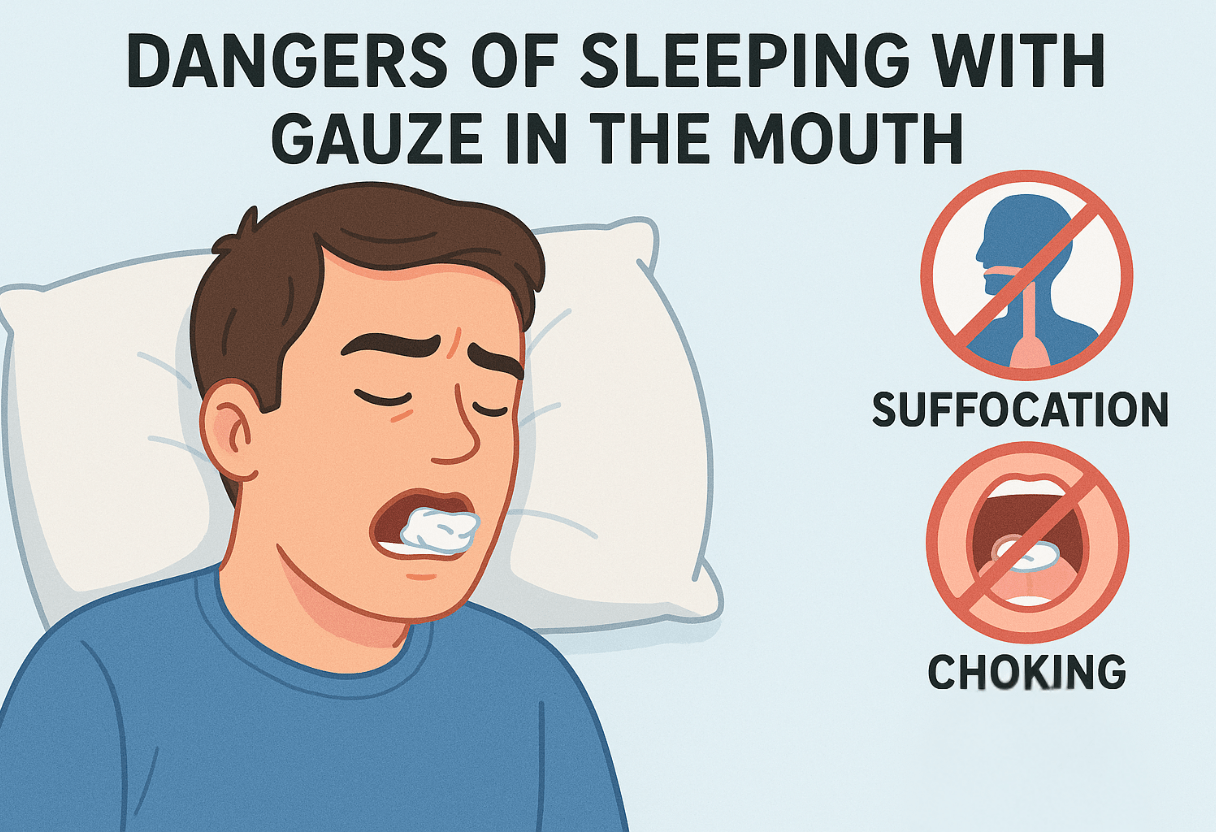The recovery from wisdom tooth removal can be painful, particularly when attempting to get a good night’s sleep. The best way to sleep after wisdom tooth removal is to keep the head elevated and avoid lying flat, which helps reduce swelling and supports proper healing. Such a simple adjustment can make sleeping more comfortable and can reduce the risk of complications.
Selecting the proper sleeping position is essential. Resting on your side with your head supported by additional pillows also helps get a restful way of sleeping. Avoiding pressure at the surgical site and adhering to pain control guidance also contribute significantly to enhanced sleep quality following recovery.
A relaxed and cool atmosphere can also help relieve tension and induce relaxation. Familiarity with these steps will make the recovery process easier and less taxing.
Key Takeaways
- Raising the head when sleeping reduces swelling and facilitates healing.
- Side sleeping helps comfortable rest without pressure on wounds.
- Cool, quiet sleep space is responsible for enhanced post-surgery recovery.
- The right mattress with medium support, pressure relief, and motion isolation helps make sleeping after wisdom tooth extraction more comfortable and aids recovery.

Immediate Post-Extraction Sleep Guidelines

After post-wisdom tooth extraction rest, sleeping properly helps to recover, reduce pain, and swelling. Remaining strictly within clear, concise instructions can maximize comfort and restrict harm on the initial night and subsequent days following surgery.
Sleeping Safely the First Night
The best sleeping position after the extraction of wisdom teeth is in a head-elevated position. This is accomplished by using one or two pillows to hold the head, which promotes blood clotting in the wound and reduces swelling. A flat sleeping position can result in bleeding and delay healing.
Sleeping with gauze in the mouth is not recommended because it can cause choking or shortness of breath. Gauze must be kept in place for a short period of time and removed before sleeping unless told otherwise by a dentist or oral surgeon.
Side sleeping is typically recommended, as the head will be held in a propped-up position. Avoid sleeping on the extraction side because pain and swelling can become worse.
Managing Bleeding and Swelling at Night
Bleeding control is an issue on the first night. Applying light pressure with gauze over the extraction site for 30 to 45 minutes after surgery helps in blood clot formation. After gauze removal, spitting or forceful rinsing of the mouth should be avoided.
Ice packs to the cheek in 10 to 20 minute intervals for the first 24 hours can also reduce swelling. The cold reduces blood flow to the area and keeps one comfortable, allowing better sleep.
Raising the head also assists with swelling, along with keeping blood from pooling in the mouth that can cause painful swallowing or coughing during sleep.
Not to Do Right After Surgery
There are a few things not to do in an effort not to jeopardize the healing area. Smoking and drinking alcohol must not be done by the patient for 24 hours following the surgery. Both delay clotting and healing.
Do not brush directly the extraction site the first day to prevent loosening the blood clot. Also, sleeping in late is not recommended, as the body needs rest to heal properly.
Swallowing or spitting hard, drinking through straws, or chewing on tough foods can interfere with the wound. These tendencies may lead to dry socket, which is a painful complication. Adhering to the surgeon’s instructions closely minimizes these threats.
Optimal Sleep Positions for Recovery
After wisdom tooth extraction, proper sleeping position can reduce swelling, alleviate pain, and protect the operated site. Proper head positioning and not applying pressure on the site are crucial for an uncomplicated course. Knowing when to modify sleeping habits and how to prevent healing tissues to be compromised from and also prevents complications.
Sleeping on Your Back vs Side
Lying on the back is typically the most comfortable position after wisdom tooth surgery. It reduces the risk of irritation or reopening of the wound because it doesn’t put pressure on the operating area. The position also aids in enhanced airflow to the mouth to prevent bacteria growth.
Side sleeping, especially the extraction side, is not recommended following surgery. Lying on the extraction side makes the swelling worse and can prolong healing. It may also prolong bleeding or dislodge the blood clot, leading to complications like dry socket.
Most dental professionals suggest avoiding side sleeping for a minimum of 3 to 5 days after the extraction. Sleeping on your back or semi-upright sleeping should be prioritized within those first few days to protect the area and allow healing to begin on the right foot.
How to Elevate Your Head Properly
Elevating the head during sleep reduces blood flow to the area of extraction, thus reducing swelling and bleeding to a great extent. The head must be elevated at a height of approximately 45 degrees. This can be achieved by utilizing two or three firm pillows placed beneath the upper back and neck. It can also be used with a foam wedge pillow so that the head is maintained level without adjusting pillows during the night. It prevents the head from rolling side-ward and possibly putting pressure on the wound area.
If pillows alone are not adequate to raise the head high enough, wedging the bed head with sturdy blocks or bed raisers can give a gentle slope. This is especially helpful in the first 48 to 72 hours post-surgery when there is maximum swelling.
When to Resume Side Sleeping
Patients are typically able to return to sleeping on their side after swelling and tenderness have largely subsided, usually within a week. The recovery time varies depending on the person’s healing and the difficulty of the extraction.
If the person prefers to sleep on their side, they should always ensure they never lie on the extraction side to prevent applying pressure and irritating the wound. It also helps to sleep on the opposite side to reduce risk and encourage continued healing.

Managing Pain and Swelling for Better Sleep
Pain and swelling management is most critical in sleeping well after wisdom teeth removal. Correct medication, cold packs, and calming evening activities all help reduce pain and improve quality of sleep.
Medication Time and Suggestions
Taking medication for pain on time keeps discomfort minimal, particularly in the initial 48 hours following surgery. Patients should take their medication just as instructed by their doctor if prescribed. Over-the-counter medications such as ibuprofen are quite effective in reducing pain and swelling. For instance, a one-time 400 mg dose of ibuprofen is better compared to high doses of acetaminophen. The combination of ibuprofen and acetaminophen in dosage recommended amounts can alleviate pain better than either of them alone.
Pain medication needs to be taken in synchrony with peak levels earlier in the evening to allow for sleeping. Don’t skip any doses even when experiencing slight pain because frequent relief avoids flare-up during the night. Always consult with the oral surgeon before taking any other medications.
Using Ice Packs Effectively
Applying ice packs to the jaw in the first 24 to 72 hours after extraction reduces swelling and pain. Wrap the ice in a towel to avoid skin damage. Apply the pack 10-20 minutes and remove 10-20 minutes. Repeat the interval every few hours and early in the evening.
Raising the head with extra pillows helps complement ice therapy by encouraging fluid drainage and reducing swelling. Ice is not to be used just before bed out of fear of constriction or discomfort. See tips on how to shrink wisdom teeth swelling overnight for precise cold therapy instructions.
Nighttime Routines to Reduce Discomfort
A calming pre-sleep routine can ease the way into sleep. The bedroom needs to be kept cool and dark by the patients, which helps sleep better despite pain. Sleeping with the region of extraction above the head on the affected side reduces pressure and swelling. Avoid lying flat on the back, which might lead to increased blood flow and swelling of the face.
Gentle activities such as soft music or deep breathing may be distracting from pain. Do not brush near wounds before bedtime for a minimum of 24 hours. Patients should also not drink alcohol and should not smoke since they slow the healing process and aggravate symptoms.

Gauze Use and Sleep Safety
After the removal of wisdom teeth, bleeding control is important but must be performed safely. Proper use of gauze prevents bleeding, but sleeping with gauze in your mouth is very risky. It’s imperative that you understand when and how long you can sleep with gauze to prevent issues and sleep securely.
Do You Need to Sleep with Gauze?
You should never go to sleep with gauze in his mouth after wisdom tooth surgery. Gauze is only intended to control bleeding after surgery and usually only for 20 to 30 minutes at a time. If there is persistent bleeding, fresh gauze can be placed during the day while awake but not safe to stay overnight.
Gauze that has been left in place during sleeping can cause choking or airway blockage, especially in a patient who is still under sedation or anesthesia. Pre-reclining gauze removal reduces the chances of swallowing or accidentally inhaling it.
For heavy or prolonged bleeding that lasts more than hours, the patient is encouraged to call his or her dentist instead of using overnight gauze placement. This guidance ensures safer healing and rest.
Dangers of Sleeping with Gauze in the Mouth
Sleeping with gauze in the mouth also risks more choking and airway obstruction. The gauze slips down the throat very easily when one is asleep or even half-asleep. It creates a choking object that might lead to breathing difficulties or mishaps. In addition, prolonged use of gauze without close monitoring can interfere with blood clotting. The clot protects the surgical site, and its removal can lead to dry socket, a painful complication which delays healing.
Because of these hazards, gauze use is limited to short periods for a duration of being awake. Gauze removal at night with care is an important safety protocol following tooth extraction.

Creating a Sleep-Friendly Environment

Rest following wisdom tooth removal is essential to the healing process, but swelling and pain can make it hard to sleep. Establishing the appropriate environment and habits can alleviate pain and aid in the healing process.
Optimal Bedroom Environment for Recovery
The bedroom must be dark, quiet, and cool to induce quality sleep. Cold air decreases swelling and pain. Dim light tells the body to release melatonin, an aid to sleep. You may use more pillows to maintain the head higher than the heart. Sleeping in a 45-degree angle reduces blood circulation to the operation site, lowering swelling and pulsating pain.
Turning off screens and reducing noise distractions also soothes the mind. Blackout curtains or an eye mask provides total darkness that aids in deeper stages of sleep required for healing.
Pre-Bedtime Habits
Before bed, relaxing activities can alleviate pain and anxiety. He or she will not use stimulating screens such as TV or phones at least 30 minutes prior to bedtime. Lying down 30 to 60 minutes in advance can be made more comfortable by taking prescribed pain medication or ibuprofen doses. A cold compress applied to the jaw in advance controls swelling.
Brushing close to the extraction area should not be done as this can dislodge the healing clot. Rinsing carefully with saltwater later on after the initial 24 hours decreases bacteria without dislodging the wound.
Diet and Fluid Intake Prior to Sleeping
Consuming soft foods that don’t need heavy chewing guards the healing wounds. Yogurt, smoothies, scrambled eggs, and mashed potatoes are examples. It is best to avoid hot or spicy meals close to bedtime since they can aggravate the mouth and make blood flow more, worsening swelling.
Caffeine and alcohol should be avoided close to bedtime since they are likely to interfere with sleep and prolong healing. Drinking water also prevents dry mouth, which is uncomfortable during sleep.
Troubleshooting Sleep Issues After Extraction
Sleep may be elusive following wisdom tooth extraction due to discomfort, pain, or swelling. Proper management of these challenges can enhance sleep and contribute to healing.
What to Do If You Can’t Sleep
If you have trouble sleeping after wisdom teeth removal, managing pain is the priority. Taking prescribed pain medication or ibuprofen as instructed usually works. Squeezing an ice pack against the jaw in 10- to 20-minute increments can help decrease swelling and also alleviate discomfort.
Raising the head using additional pillows prevents fluid accumulation and minimizes swelling. Side sleeping with an elevated head is more comfortable than supine sleeping on the back.
Making a quiet, cool, and dark environment helps to relax. Abstaining from caffeine, alcohol, and smoking is crucial since they may hinder healing and aggravate sleeping. When the pain or swelling increases, medication should be adjusted or the surgeon should be contacted.
When to Seek Professional Help
If pain increases or changes in quality after several days, infection or dry socket may be present, a complication when blood clots become dislodged from the wound site. Warning signs would include intense pain, foul taste in the mouth, swollen lymph nodes, fever, or pus. If these occur, one should contact the oral surgeon immediately.
Chronic failure to sleep because of swelling or pain for more than a week also requires a professional consultation. The doctor might need to investigate complications or modify treatment to aid in recovery. This immediate response prevents the healing process from being delayed and causing more pain.

Long-Term Sleep and Healing Considerations
Adequate healing and resting after wisdom tooth removal need continued care even after the initial days. Taking control of pain, swelling, and changes in sleeping patterns are essential to full recovery. Tracking signs of healing prevents complications and tells us when to resume normal sleeping patterns.
Signs of Proper Healing
Recovery from wisdom tooth extraction typically is a matter of several weeks. Most important are decreased swelling and less discomfort each day. The healing site will begin closing, and bleeding or oozing will stop within several days. If pain decreases and does not worsen, it’s an indication that healing is ongoing. The individual should also experience increased ability to open the mouth and comfortably eat soft foods.
Signs that require attention are new or increased pain, swelling lasting longer than a week, foul taste or odor in the mouth, or swollen lymph nodes in the jaw. These may indicate infection or dry socket and need attention from a dentist.
Changing Sleeping Habits Over Time
During the first week, sleep with the head raised. This decreases swelling and facilitates blood clotting. Side resting is generally advised to avoid putting pressure on the extraction area. Once initial days are over, pillows can be reduced gradually as swelling subsides. Regular sleeping position can be resumed when pain and swelling are well managed.
Keeping from sleeping on the back flat during the initial phase prevents complications. Proper sleep hygiene, such as a cool, dark room, is supportive of the healing body. Pain medication and oral care instructions assist in comfortable sleep during recovery. Gradually changing sleep habits coincides with tissue healing and pain decrease.
Choosing the Right Mattress for Comfortable Sleep After Wisdom Tooth Extraction
The appropriate mattress is also important to healing from wisdom tooth extraction. Supportive bed surfaces stabilize the body, reducing pressure points and bringing overnight comfort within reach.
Hybrid mattresses are for recovery. These mattresses mold to the body for even support as they cushion pain-sensitive areas. A firm mattress that isn’t too hard keeps from sinking too far, reducing the likelihood of pressure redistribution to other body areas and discomfort.
Major mattress features to keep in mind:
- Medium support – preserves spinal alignment
- Pressure relief – eases body pain
- Motion isolation – minimizes disruption from movement
Don’t forget to consider mattress height, either. A low enough height that’s easy to get on and off reduces unnecessary strain, particularly significant when raising the head to minimize swelling. With the help of a supportive pillow, comfort is increased. Head elevation helps in healing by minimizing swelling, while head and neck-stabilizing pillows promote restful sleep and minimize tossing.
Ultimately, finding a mattress that is best suited to your individual comfort and support requirements makes post-extraction wisdom tooth sleep more comfortable and less painful.
For those who want a premium choice, the Nolah Evolution 15” mattress is a perfect fit. Its medium firm, zoned coil design and pressure-relieving Airfoam ensure it is both supportive and comfortable, which can minimize strain when sleeping in raised positions. With its longevity-focused construction and cooling technology, it provides lasting comfort that accommodates recovery and daily sleep.

Frequently Asked Questions
Improved care during sleep following wisdom tooth removal minimizes pain, swelling, and the danger of complications. Complying with certain recommendations regarding sleep positions and dealing with materials in the mouth facilitates more convenient healing.







